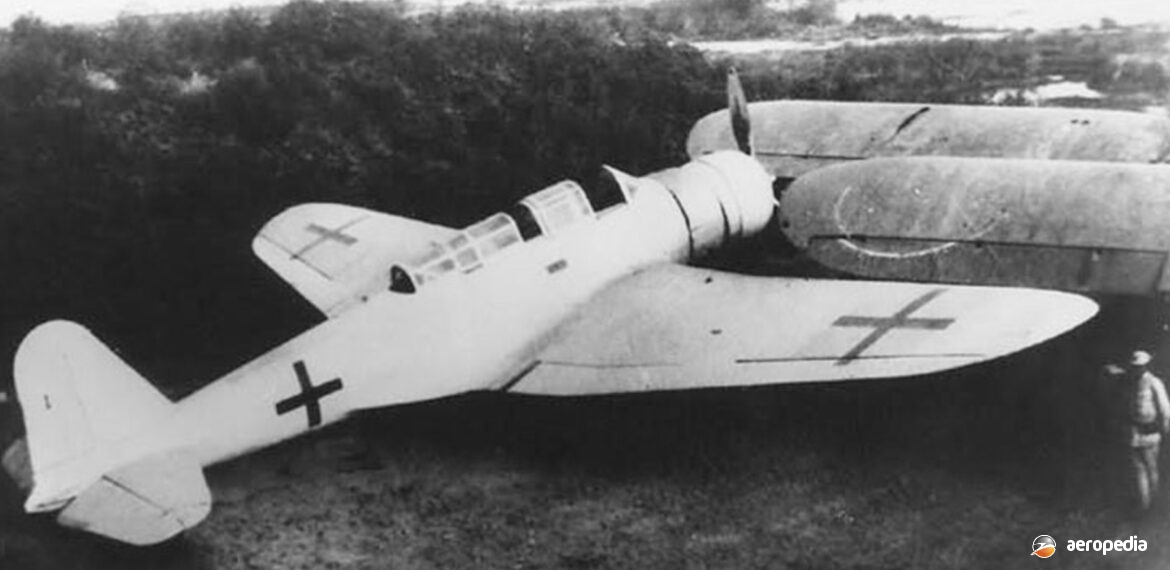Photograph:
Nakajima B5N ‘Kate’ surrender aircraft (RAAF Museum)
Country of origin:
Japan
Description:
Three-seat carrier-borne attack bomber
Power Plant:
One 746 kw (1,000 hp) Nakajima Sakae II fourteen-cylinder two-row air-cooled radial engine
Specifications:
- Wingspan: 15.52 m (50 ft 11 in)
- Length: 10.33 m (33 ft 10 in)
- Height: 3.71 m (12 ft 2 in)
- Wing area: 38.27 m² (412 sq ft)
- Max speed at 3,000 m (9,842 ft): 378 km/h (235 mph)
- Cruising speed at 3,000 m (9,842 ft): 264 km/h (164 mph)
- Landing speed: 116 km/h (72 mph)
- Time to 3,000 m (9,842 ft): 7 mins 40 secs
- Service ceiling: 7,681 m (25,200 ft)
- Normal range: 1,020 km (634 miles)
- Max range: 1,992 km (1,238 miles)
- Empty weight: 2,191 kg (4,830 lb)
- Loaded weight: 3,792 kg (8,360 lb)
Armament:
One flexible 7.7 mm (0.303 in) type 92 machine gun in rear cockpit; provision to carry three 250 kg (550 lb) or one 800 kg (1,760 lb) torpedo
History:
The B5N series (Type 97 Attack Bomber) was designed by the Nakajima Aircraft Co Ltd of Ota, Japan as a carrier-borne dive bomber, the prototype fitted with a 574 kw (770 hp) Nakajima Kikari 3 radial engine, first flying in January 1937. The type entered service in 1937, the first production model being known as the Navy Type 97 Model I. In December 1939 the B5N2 appeared, this having a 746 kw (1,000 hp) Nakajima Sakae engine and became known as the Type 97 Model 3, but was later designated Model 12.
The operational debut of the type was as close air-support for the Japanese Army in the Hankow region of China in 1938. In 1940 Japanese forces moved into French Indo China; and on 7 December 1941 the type was on board six Japanese aircraft carriers, the Akagi, Kkagi, Hiryu, Suryu, Zuikaku and Shokaku, and was part of a strike force of 353 aircraft which attacked Pearl Harbour, Hawaii. From 5 to 7 May 1942 the Coral Sea battle took place and the Japanese carriers Zuikaku, Shokaku and Shotto were involved in the attempted invasion of Port Moresby, NG. Later the ‘Kate’ saw service during the Battle of Midway in June, when the Japanese forces suffered devastating losses, four Japanese Navy carriers being sunk. Later the type was involved in operations in the Solomons in September, Santa Cruz in October, and Guadalcanal. In June 1944 they were involved when US forces attacked the Marianas. Eventually a number were used in Kamikaze suicide attacks off Okinawa Island, Japan.
On 19 February 1942 Darwin was attacked by the same aircraft carrier groups which had some weeks before attacked the islands of Hawaii, on this occasion the force comprising 71 Aichi D3A ‘Vals’ and 81 Nakajima B5N ‘Kates’ escorted by 36 Mitsubishi Type O Zero fighters. The attack commenced about 9.45 am local time and the aircraft arrived from both the north and south-east directions, bombing shipping in the harbour as well as the wharves, flying boats etc. At 10.30 am land-based bombers from Kendari in the Celebes arrived over Darwin, NT, having flown 1,400 km (870 miles), and attacked the Darwin aerodrome.
On 2 March 1943 Coomalie Creek airstrip in the Northern Territory, base for RAAF Beaufighters, was attacked by a force of Japanese aircraft said to comprise nine Mitsubishi G4M ‘Bettys’ escorted by 20 Mitsubishi A6M Zero fighters. RAAF reports indicate the force was much larger and that it included ‘Kate’ light bombers. Be that as it may, the force was intercepted by 24 Supermarine Spitfires of Nos 54 and 457 Squadrons, and one ‘Kate’ was destroyed by Wing Commander Clive Caldwell, and one Zero was destroyed by Sqdn Ldr RH ‘Bobby’ Gibbs. After the war many were abandoned at Pacific wartime strips, being unable to be evacuated due to lack of time and parts, and at least one of these equipped with radar was taken to the United States where it underwent evaluation at the Naval Air station at Anacostia.
In 2003 a B5N2 (53-305) of the 553rd Kokutai was shipped to the United Kingdom following its recovery from Shumusha Island in the Kuril chain in the former Soviet far east. Other ‘Kates’ which survived the war were a B5N2 acquired by American forces on Saipan in 1945, which was restored and tested before being broken up, and one under long-term restoration at the Pacific Aviation Museum at Ford Island on Hawaii.
An example, a B5N2 (tail number 302), was surrendered on 15 August 1945 to RNZAF forces at Jacquinot Bay near the former Kavieng seaplane base off New Ireland. It was flown by a Japanese pilot from Vanakunau to Jacquinot Bay airfield on New Britain, escorted by RNZAF Corsairs of No 16 Squadron. It was expected to become a war prize. However, due to lack of space on returning ships, could not be shipped to New Zealand and was abandoned. It was one of a number of Japanese aircraft which were flown to Vanakunau Airfield from Rabaul, these aircraft including a Mitsubishi Ki-46 ‘Dinah’, three A6M5 Zeros and an E13A ‘Jake’. In the 1970s it was still at the airfield standing on its undercarriage but by 1981 it and the ‘Dinah’ had been broken up. The engine survives at the Kokopo Museum at Rabaul.
In 2003 the remains of the ‘Kate’ and the ‘Dinah’ were said to have been conveyed to Lae, NG and were eventually exported. The ‘Kate’ aircraft was shipped to Australia in 2005. It was later purchased by the Pacific Aviation Museum in Hawaii. In 2012 it was rumoured that this example of a ‘Kate’ was somewhere in New Zealand. In 2014 it was shipped to Hawaii. The aircraft is reasonably complete except for the engine and is displayed as it was recovered.
I

